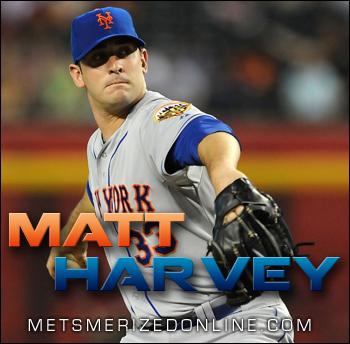With one final start slated for Matt Harvey this season, it’s a good time to evaluate what we have seen from the young fireballer in 2012. Like many speculated, he had some really great outings, and some that would be best if forgotten all together. It is expected that the Mets young righthander will have his ups and downs, but Harvey has ultimately done enough to lock down a spot in the Mets starting rotation for 2013.
Harvey’s Overall Grade: B
Harvey easily could have received an A had it not been for a couple of bad starts which followed his debut. Aside from the solid B grade, there are some things Harvey will have to work on during the off-season which will help solidify his spot at the top of the Mets rotation for years to come.
Harvey’s Changeup
This is the pitch that got Harvey into a good amount of trouble in his few starts with the Mets. He tends to leave it up in the zone, which makes it easy for hitters to jump on. He has to learn what situations to use it in, and work on keeping it down in the zone. To be an effective out pitch, he should only use it very sparingly (like he has done in his more successful starts this season).
Harvey’s Fastball
Harvey has the luxury of a blazing 97mph fastball, which isn’t a luxury many pitchers have, but that isn’t necessarily enough to get big league hitters out. He throws a four-seam fastball which tends to be flat and doesn’t have a lot of movement. If he leaves that pitch up in the zone, major league hitters will jump on it. By keeping that pitch down in the zone, he will generate more ground balls, and ground balls tend to be outs – if he leaves it up in the zone, he will generate more fly balls, and fly balls can easily become homeruns. If I was the Mets pitching coach, and I had a kid throwing 97mph, I would have him develop a two-seam fastball to compliment the four-seamer. The two-seam fastball would make that 97mph heat much harder to hit due to the movement that comes with throwing that pitch with that much velocity. I would have him use the four-seamer to bust hitters in on the inside half of the plate. Harvey should set himself a little goal to break two to three bats per game. It will subconsciously force him to pitch inside which will make him much more dominant. By busting hitters in, it will also make his curveball that much more effective. Major league pitchers don’t pitch inside enough, and Harvey has an opportunity to start this trend again. He has to make sure those hitters are not comfortable up in the batter’s box when they face him.
What I really liked this year from Harvey was that I don’t think he ever shook his catcher off (at least when I have seen him pitch he hadn’t). This demonstrates he recognizes the fact that he is a young pitcher, who still has a lot to learn about pitching at the major league level. He relied on the guidance of his catchers which showed a level of maturity that is impressive for a young pitcher. I also liked his strikeout to inning ratio. It’s a general rule of thumb that a pitcher should average about one strikeout per inning – Harvey has had 63K in 52 innings which is a 1.21 K/9. His ERA was solid, and the Mets should be very pleased with Harvey’s call up in 2012.
I never watched Matt Harvey pitch in the minor leagues until they televised his start on SNY right before his major league callup. I was actually on the phone during that game with Joe Decaro, owner of metsmerizedonline.com, and remember telling him how unimpressed I was with Harvey’s stuff. I thought he was going to get lit up by major league hitters. Evidently, I might not have been the only person that held similar reservations. In an article written earlier today by Adam Rubin of ESPN, he references a quote from Terry Collins and Wally Backman regarding Harvey’s performance since being called up:
“This guy has taken the game to another level when he got up here,” Collins said. “You’re standing in the dugout next to Wally, who saw him more than I did all year. When Wally says, ‘I never saw that. I never saw kind of stuff,’ it tells you how he can raise his game.”
I felt the same way after seeing him pitch at the major league level compared to what I saw that night on SNY when he was pitching for the Buffalo Bisons. It was night and day.
There will be some that say that the reason why he had so much success at the major league level is the same reason why we see a lot of guys get off to incredibly hot starts when they first get called up – because there is little known about them. The major league players have not seen enough of Harvey to make adjustments, but once they do, the honeymoon may be over. Everyone remembers Shane Spencer. He’s the poster boy of the hot start turned ice cold. That’s why it is crucial for Harvey to develop a solid changeup and two seam fastball – he cannot rely on a four seam fastball and curveball if he is going to continue to experience the level of success he has had over the past couple of months. It could mean the difference between Harvey becoming the next great Mets pitcher, or the next Shane Spencer.
My money is on Harvey becoming the next great Mets pitcher.
What sold me was his comments after last night’s game in which he struck out ten…
“The biggest thing for me is going deeper into games and figuring it out a lot sooner, and not pressing to go for the strikeout all the time. I have to get early contact. That’s the biggest thing I’m going to work on.”
This kid gets it…
Regardless of what critics may say about him, Harvey was definitely one of the few bright spots in 2012. He has given the Mets fans a reason to believe there may be a light on the other end of the tunnel.















